Every time I make Fish Escabeche, my kids come running to the kitchen, drawn by the sweet-tangy aroma that fills our home.
Like many Filipino moms, I struggled to get my little ones to eat fish until I discovered this family recipe passed down from my Lola.
The crispy fried fish gets transformed by a vibrant sauce that perfectly balances sweet and sour flavors, making it so irresistible. It's become our Sunday family lunch favorite, and even my choosy 7-year-old asks for seconds, especially when the sauce mingles with steaming white rice.
What I love most about this Escabeche recipe is how it turns simple ingredients into something special enough for both family meals and fiestas. The golden-crispy fish draped in a bright sauce with tender-crisp bell peppers and onions not only looks stunning on the table but tastes even better the next day (if there are any leftovers).
After years of making this fish escabeche recipe, I've perfected little tricks to get that restaurant-quality taste at home, and I'm excited to share them all with you.
What is Fish Escabeche?
Fish Escabeche (Pesang Escabetse) is a heritage Filipino dish with Spanish-Latin American roots. It features whole fish fried until golden crisp, then draped in a bright sweet-sour sauce made from vinegar, sugar, and tender-crisp bell peppers and onions, creating a harmonious blend of crispy, tangy, and sweet elements in each bite.
Jump to:
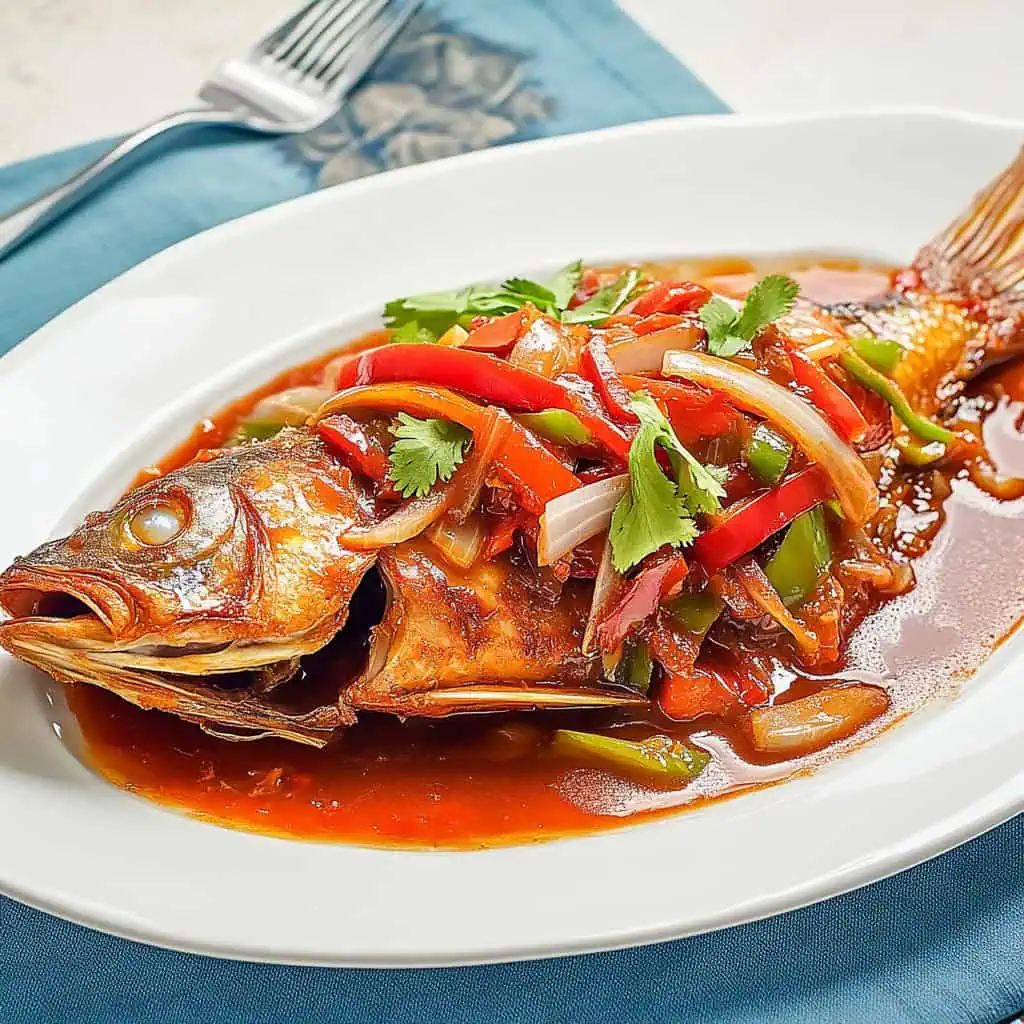
Why You'll Love This Recipe
- Perfect balance of sweet and sour flavors (matamis-asim)
- Crispy fried fish combined with tender-crisp vegetables
- Make-ahead friendly – tastes even better the next day
- Impressive presentation for special occasions
- No hard-to-find ingredients needed
- Naturally gluten-free
Ingredients
This recipe combines simple yet powerful ingredients that create culinary magic. The firm white fish provides the perfect canvas for the vibrant sweet-sour sauce. Vinegar brings necessary acidity while sugar balances it with sweetness, the key to authentic Filipino flavor.
Red bell peppers and onions add fresh crunch, color, and natural sweetness, while garlic and black peppercorns infuse the sauce with aromatic depth. Salt enhances all these flavors, bringing everything together.
This careful balance of ingredients creates the signature escabeche experience: crispy fish bathed in a sauce that's tangy, sweet, aromatic, and utterly irresistible when spooned over steaming rice.

- 1 large whole fish (1-2 lbs) - tilapia, lapu-lapu, or red snapper
- 1 tablespoon salt
- ½ cup cooking oil
- 1 cup white vinegar
- ¼ cup sugar
- 1 medium red bell pepper, julienned
- 1 medium red onion, sliced into rings
- 5 cloves garlic, crushed
- 1 teaspoon whole black peppercorns
- ½ teaspoon salt
Equipment
- Large non-stick frying pan or kawali: For frying the fish to golden perfection without sticking
- Medium saucepan: For preparing the sweet and sour sauce
- Sharp knife and cutting board: For precise vegetable cutting and fish preparation
- Spider strainer or tongs: For safely removing the fish from hot oil
- Measuring cups and spoons: For accurate ingredient measurements
- Paper towels: For draining excess oil from the fried fish
- Serving platter: For beautiful presentation of the finished dish
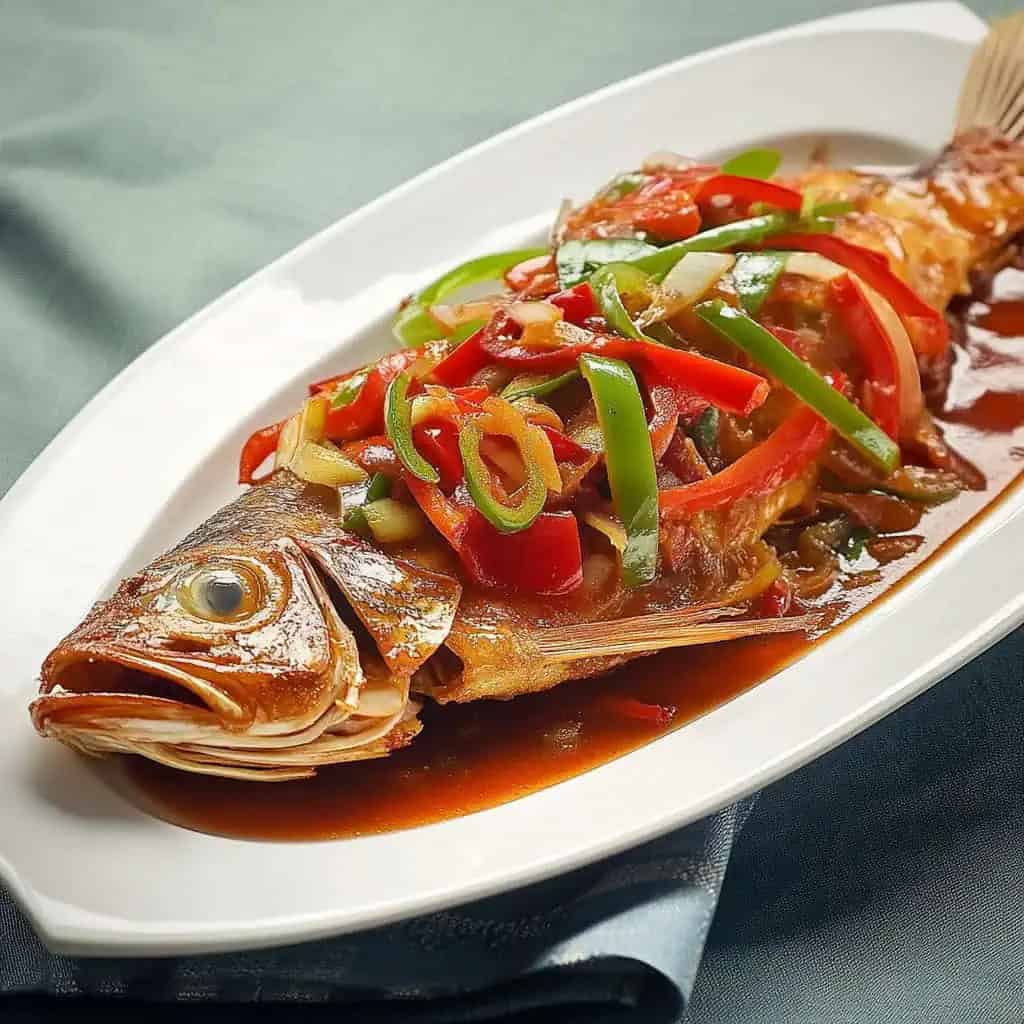
How To Make
- Before starting, gather all your ingredients and equipment.
- Clean your fish thoroughly, removing all scales and innards. Make 3-4 diagonal cuts on each side of the fish, about half an inch deep. Rub salt all over the fish, making sure to get some into the cuts and cavity. Let the fish rest for 10 minutes to reduce fishiness.
- Heat half a cup of cooking oil in a large pan over medium-high heat. When the oil is hot (you can test by dropping a tiny piece of bread – it should sizzle immediately), carefully put the fish in. Fry each side for 7-8 minutes until golden brown and crispy. Remove the fish and place on paper towels to drain excess oil.
- In a clean pan, pour one cup of white vinegar and turn the heat to medium. Let it come to a boil. Add quarter cup of sugar and stir until it dissolves completely. Add your crushed garlic and whole peppercorns. Let these cook for 1 minute until you can smell the garlic.
- Add your sliced red onions and bell peppers to the pan. Cook them for 2-3 minutes until they're slightly soft but still crispy. Add half a teaspoon of salt and stir everything together.
- Carefully place your fried fish into the pan with the sauce. Gently spoon some of the hot sauce over the fish. Let everything cook together for 2-3 minutes. Turn off the heat and let it rest for 5 minutes.
- Transfer everything to a serving plate, making sure to pour all the sauce and vegetables over the fish. For the best flavor, let it sit for 15 minutes before serving. You can serve this hot or at room temperature, always with plenty of steaming white rice.
Remember: Don't throw away the sauce! It's perfect for pouring over your rice. Store any leftovers in the refrigerator and enjoy within 3 days. The flavor actually gets better the next day.

Tips from Lola's Kitchen
- Choose fish with clear eyes and bright red gills for maximum freshness
- Pat fish dry thoroughly before frying to achieve that irresistibly crispy skin
- Don't move the fish while frying – patience allows it to form a good crust that won't stick
- If sauce is too sour, add a little more sugar (1 teaspoon at a time) until balanced
- For extra aromatic depth, add 2-3 bay leaves (laurel) to the sauce
- Let the dish rest 15-20 minutes before serving to allow flavors to fully develop
- Score the fish deeper if you prefer more sauce absorption into the flesh
- Remove any stray fish scales before cooking to prevent an unpleasant texture
Substitutions
- Fish: Any firm white fish works - pompano, bangus (milkfish), or maya-maya. For a more approachable version, fish fillets work great too
- White vinegar: Cane vinegar offers a milder tang, while apple cider vinegar brings a subtle fruity note
- Bell peppers: Green or yellow bell peppers provide different flavor profiles and visual appeal
- Sugar: Palm sugar or brown sugar add a deeper caramel note to the sauce
- Red onion: White onions work fine but provide a sharper flavor and less color
- Peppercorns: Ground black pepper (¼ teaspoon) can replace whole peppercorns in a pinch
- Oil: For a healthier version, use olive oil or avocado oil instead of regular cooking oil
Troubleshooting
- Fish breaks apart: Make sure your oil is hot enough (350°F/180°C) before adding fish. Also, handle the fish minimally during cooking
- Too sour: Add sugar gradually, 1 teaspoon at a time, until you reach your desired sweetness
- Too sweet: Balance with additional vinegar, starting with 1 tablespoon
- Fish not crispy: Ensure fish is completely dry before frying and don't crowd the pan
- Sauce too thick: Add 2-3 tablespoons of water or fish stock to reach desired consistency
- Sauce too thin: Simmer uncovered for a few extra minutes to reduce
- Vegetables too soft: Add them later in the cooking process or blanch them separately
- Too fishy taste: Soak fish in milk for 20 minutes before cooking to reduce fishiness
Storage & Reheating
- Refrigerator: Keep in an airtight container for up to 3 days - flavors actually improve overnight!
- Room temperature: Safe at room temperature for up to 4 hours (perfect for parties)
- Reheating: Best served at room temperature, but can be gently reheated in a covered pan over low heat for 3-5 minutes
- Microwave: If necessary, microwave on 50% power with a damp paper towel over the dish
- Freezing: Not recommended as vegetables will become mushy and fish texture will deteriorate
- Sauce only: Leftover sauce can be refrigerated separately for up to 5 days and used as a dressing or marinade
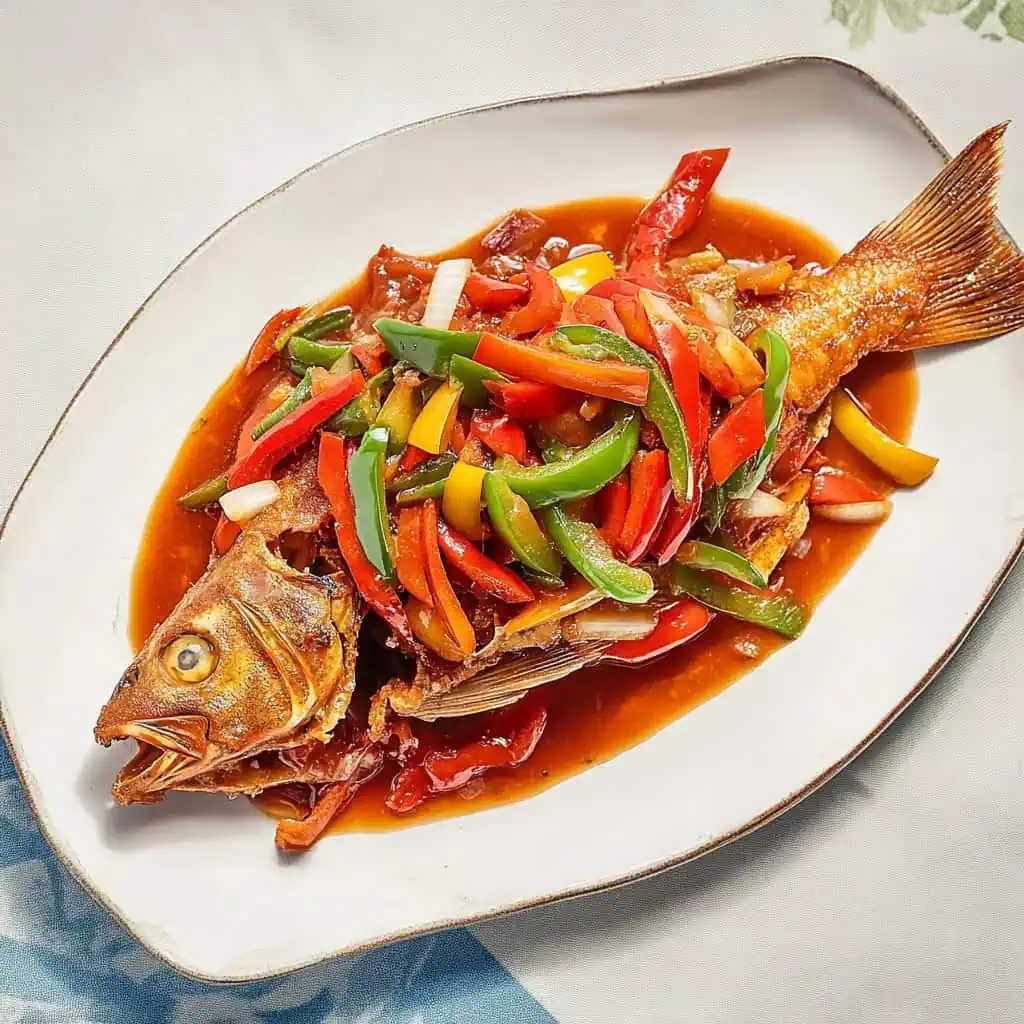
FAQ
Can I use fish fillets instead of whole fish?
Absolutely! Reduce cooking time to 3-4 minutes per side and be gentle when adding to the sauce.
Why is my fish not crispy?
Make sure to pat the fish completely dry before frying and ensure your oil is hot enough (180°C/350°F).
Can I make this in advance for a party?
Yes! It actually tastes better after sitting for a few hours or overnight. Store in the refrigerator and bring to room temperature before serving.
Is this the same as ceviche?
No, escabeche uses cooked fish while ceviche uses raw fish cured in citrus juice.
How spicy is this dish?
The traditional version is not spicy at all, but you can easily add chilies to taste for heat.
Can I use this sauce for other proteins?
Absolutely! This sweet-sour sauce works wonderfully with fried tofu, chicken, or pork.
What's the best rice to serve with Escabeche?
Jasmine rice or any medium-grain white rice complements the sauce perfectly.
How do I know when the fish is fully cooked?
The flesh should be opaque and flake easily with a fork. Internal temperature should reach 145°F (63°C).
Can I add other vegetables to the sauce?
Yes! Carrots, celery, and even pineapple chunks make excellent additions.
Is this dish keto-friendly?
The traditional recipe is not, but you can substitute sugar with monk fruit sweetener for a low-carb version.
Related
Looking for other recipes like this? Try these:
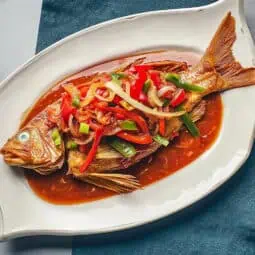
Filipino Fish Escabeche (Pesang Escabetse)
Equipment
- Large non-stick frying pan or kawali (for frying fish)
- Medium saucepan (for the sauce)
- Sharp knife and cutting board
- Spider strainer or tongs (panghimay)
- Measuring cups and spoons (Panukat)
- Paper towels
- Serving platter (bandehado)
Ingredients
For the Fish
- 1 large whole fish 1-2 lbs - tilapia, lapu-lapu, or red snapper
- 1 tablespoon salt asin
- ½ cup cooking oil mantika
For the Sauce
- 1 cup white vinegar suka
- ¼ cup sugar asukal
- 1 medium red bell pepper pamintang pula, julienned
- 1 medium red onion sibuyas, sliced into rings
- 5 cloves garlic bawang, crushed
- 1 teaspoon whole black peppercorns pamintang buo
- ½ teaspoon salt asin
Instructions
- Before starting, gather all your ingredients and equipment. You'll need a large whole fish like tilapia or lapu-lapu, salt, cooking oil, white vinegar, sugar, red bell peppers, red onions, garlic, and whole peppercorns.
- Clean your fish thoroughly, removing all scales and innards. Make 3-4 diagonal cuts on each side of the fish, about half an inch deep. Rub salt all over the fish, making sure to get some into the cuts and cavity. Let the fish rest for 10 minutes to reduce fishiness.
- Heat half a cup of cooking oil in a large pan over medium-high heat. When the oil is hot (you can test by dropping a tiny piece of bread – it should sizzle immediately), carefully put the fish in. Fry each side for 7-8 minutes until golden brown and crispy. Remove the fish and place on paper towels to drain excess oil.
- In a clean pan, pour one cup of white vinegar and turn the heat to medium. Let it come to a boil. Add quarter cup of sugar and stir until it dissolves completely. Add your crushed garlic and whole peppercorns. Let these cook for 1 minute until you can smell the garlic.
- Add your sliced red onions and bell peppers to the pan. Cook them for 2-3 minutes until they're slightly soft but still crispy. Add half a teaspoon of salt and stir everything together.
- Carefully place your fried fish into the pan with the sauce. Gently spoon some of the hot sauce over the fish. Let everything cook together for 2-3 minutes. Turn off the heat and let it rest for 5 minutes.
- Transfer everything to a serving plate, making sure to pour all the sauce and vegetables over the fish. For the best flavor, let it sit for 15 minutes before serving. You can serve this hot or at room temperature, always with plenty of steaming white rice.
- Remember: Don't throw away the sauce! It's perfect for pouring over your rice. Store any leftovers in the refrigerator and enjoy within 3 days. The flavor actually gets better the next day.
Tips from Lola's Kitchen
- Choose fish with clear eyes and bright red gills for freshness
- Pat fish dry thoroughly before frying to achieve crispy skin
- Don't move the fish while frying – let it form a good crust
- If sauce is too sour, add a little more sugar (1 teaspoon at a time)
- For extra flavor, add 2-3 bay leaves (laurel) to the sauce
Nutrition
The Story Behind Filipino Fish Escabeche
The story of Filipino Escabeche is a delicious chapter in our colonial history, weaving together influences from Spanish galleons, Latin American trade routes, and Filipino culinary ingenuity. While many assume this sweet-sour dish shares roots with Chinese cuisine, Escabeche actually sailed to our shores with Spanish colonizers in the 16th century. The word itself comes from the Spanish "escabechar," meaning to pickle or marinate in vinegar, a preservation technique that was crucial for seafaring Europeans.
Originally, Spanish sailors would preserve their catch in vinegar and spices during long ocean voyages. When they reached the Philippines, this preservation method found a perfect home in our archipelago's abundance of fresh fish and our love for sour flavors. Filipino cooks transformed the original preserving technique into the vibrant dish we know today, adding local ingredients and adapting it to suit our tropical climate and taste preferences.
What makes Filipino Escabeche distinct from its Spanish ancestor is our addition of sweetness to balance the sourness – a characteristic that reflects our cuisine's love for complex flavor combinations. While Spanish Escabeche remains purely savory and tangy, our version introduces sugar to create that distinctive Filipino sweet-sour profile that's become a comfort food favorite. We also made it our own by using native palm vinegar (suka) and incorporating local vegetables like bell peppers and onions, creating a sauce that's perfect for drizzling over steaming white rice.
Today, Escabeche holds a special place in Filipino celebrations and family gatherings. You'll find it gracing tables during town fiestas, Christmas celebrations, and Sunday family lunches. Each region has its own variation – some add ginger for extra warmth, others include carrots for color, and coastal areas might use various local fish varieties. The dish has evolved from a preservation method to a beloved recipe that showcases the Filipino talent for adapting foreign influences into something uniquely our own.
In modern Filipino kitchens, Escabeche continues to evolve while maintaining its essence. Home cooks experiment with different vinegars, adjust the sweet-sour balance to their family's taste, and some even create healthier versions using olive oil. Yet the heart of the dish remains the same: that perfect marriage of crispy fried fish and vibrant sauce that turns a simple meal into something special. It's a testament to how Filipino cuisine can transform a foreign cooking technique into a dish that feels like it's been part of our culture forever.
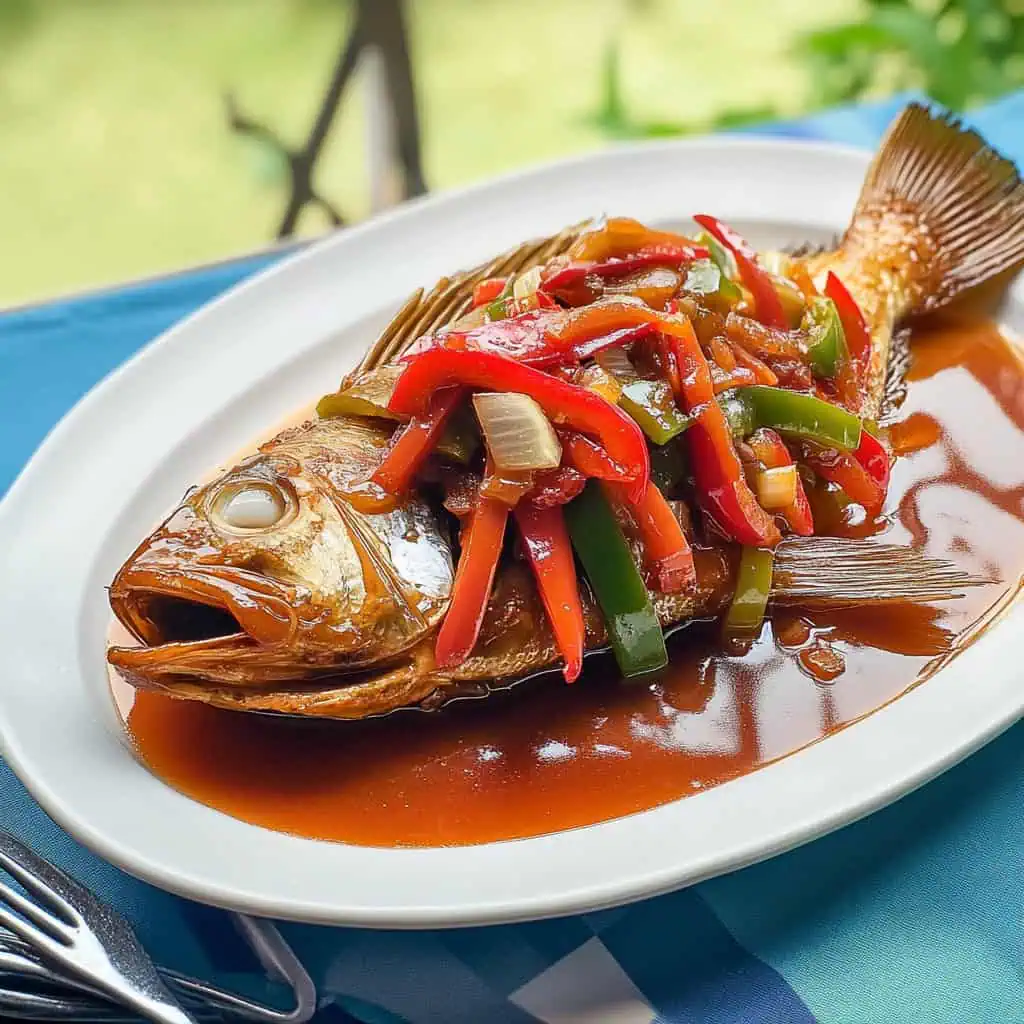









Comments
No Comments